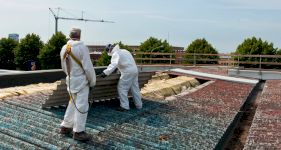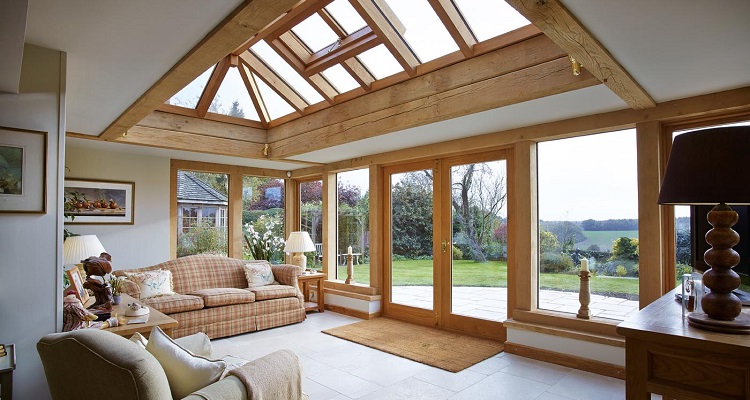Gutter Replacement Cost
- The average cost of gutter replacement is around £650 in 2025.
- It typically takes around 6 hours for a specialist to replace guttering.
- Our gutter replacement cost calculator, which gives you a quick and no-hassle way to find out how much new gutters cost.
- A breakdown of how much different types of guttering cost to get replaced (uPVC, cast iron, copper, steel, zinc, and aluminium).
- How to find and hire a local guttering specialist.
Looking to find out the cost of new guttering in the UK?
On average, a gutter replacement cost will typically be around £650. However, guttering prices you're quoted by tradespeople will vary depending on a number of factors.
This guide will give you a clearer idea of how much gutter replacement costs in 2025. It covers everything you need to know and is packed full of advice from tradespeople on MyJobQuote.
Ready to get a quote for new gutters?
MyJobQuote has a Trustpilot score of 4.8 (35,000+ reviews) and is used by more than 1 million homeowners across the UK every year.
Submit a few basic details and we'll connect you with guttering specialists near you. It's a quick and easy way to get free, no obligation quotes from local tradespeople.
Want to find out more before you start comparing prices?
We've got you covered! Continue below.
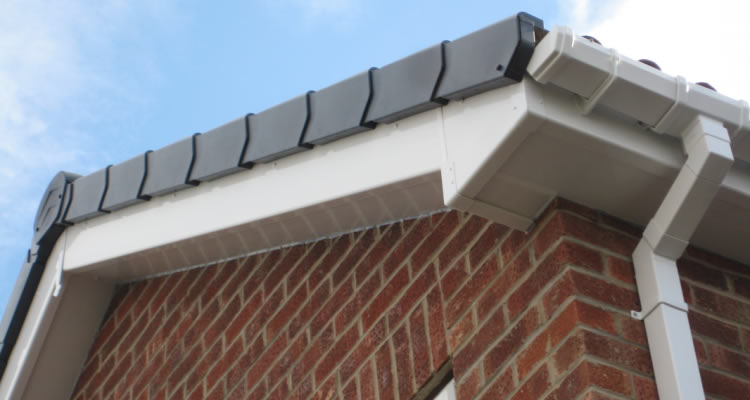
£650
Table of Contents
- How Much Does It Cost to Replace Guttering?
- How Much Does Gutter Installation Cost?
- New Gutter Costs Per Metre
- What Affects the Cost of Replacing Guttering?
- Common Guttering Issues
- Signs That You May Need to Replace Guttering
- Gutter Repair Costs
- Gutter Cleaning Costs
- Types of Guttering Materials
- Cost of Guttering Removal
- Checklist: Hiring a Gutter Fitter
- FAQs
How Much Does It Cost to Replace Guttering?
Most UK homeowners pay between £450 to £1,500 for full gutter replacement, with an average cost of around £650 for a standard three-bedroom semi-detached house.
The exact price depends on the amount of guttering needed, the materials chosen, and how easy it is for installers to access your roofline. Most full replacements take around 3–6 hours for a professional team to complete.
Guttering is usually priced per metre. For standard uPVC, expect to pay around £40 to £50 per metre for professional supply and fit. This typically includes the gutter lengths, brackets, joints, downpipes, fixings, and labour. For supply-only, basic uPVC guttering normally starts from around £4 to £7 per metre, depending on the brand and profile.
Upgrading to metal guttering increases the cost. Aluminium, cast iron, and copper systems are more durable and longer-lasting but come with higher material prices. As a guide, copper gutter lengths alone can start from around £25 per metre, with matching fittings, specialised brackets and downpipes adding to the final total.
Labour costs vary by region and access. Prices tend to be higher in London and the South East, and you may pay more if your home has difficult access, a steep roof, or requires scaffolding for safe working. While simple repairs can be cheaper, replacing old, leaking, or sagging guttering is often more cost-effective in the long term.
Want a personalised figure? Use the gutter replacement cost calculator below to estimate the price for your property based on its size and chosen guttering material.
How much does it cost to replace guttering with uPVC on the front and back of a small mid terrace house?
New Guttering Prices
Choosing the right guttering mostly depends on your budget and perhaps the aesthetic approach you are going for.
Whether it's a case of having guttering to exhibit your dream exterior, or simply to match existing guttering – be it for an older property or pairing with a neighbour's system, there are a variety of options to select from.
The tables below show typical full replacement costs (supply and fit) for different property types and guttering materials, based on quotes from tradespeople across the UK.
| Type of Property | Plastic (uPVC) | Cast Iron | Copper | Steel | Zinc | Aluminium |
|---|---|---|---|---|---|---|
| Two-Bed Terrace (26m) | £1,040-£1,300 | £1,300-£1,900 | £1,700-£2,400 | £1,100-£1,600 | £1,300-£1,900 | £1,400-£2,000 |
| Bungalow (28m) | £1,120-£1,400 | £1,400-£2,000 | £1,800-£2,500 | £1,200-£1,800 | £1,400-£2,000 | £1,500-£2,100 |
| Three-Bed Semi-Detached (32m) | £1,280-£1,600 | £1,600-£2,300 | £2,000-£2,800 | £1,300-£1,900 | £1,600-£2,200 | £1,800-£2,400 |
| Four-Bed Detached (46m) | £1,840-£2,300 | £2,400-£3,400 | £3,200-£4,400 | £2,000-£2,900 | £2,400-£3,300 | £2,600-£3,600 |
How much would it cost to replace guttering and uPVC fascia boards on a semi-detached house?
Fascia and Soffit Capping Costs
When replacing guttering, many roofers will also check the condition of the fascias and soffits. These boards sit directly behind the guttering, so any issues with them can affect how well the new system performs.
For a typical three-bedroom semi-detached house, capping existing timber fascias and soffits with uPVC boards usually costs around £800 and can be completed in roughly a day.
If the existing boards are rotten, warped, or extensively damaged, simple capping may not be suitable. In these cases, a full replacement is often recommended. Although this costs more, it provides a solid, long-lasting base for the new guttering and helps protect the roofline from water damage.
If you'd like a more detailed breakdown of prices, you can see typical costs in our fascia and soffit capping guide, and for properties where the boards are still sound but need refreshing, our soffit and fascia painting guide explains what you can expect to pay.
Replacement Gutters Cost Calculator
How Much Does Gutter Installation Cost?
Now, let's take a look at labour costs and timescales.
It can be completed within the day, on average taking between 5 to 6 hours. However, this will depend on the size of your property and whether one or two people are carrying out the work.
A typical hourly rate for the main tradesperson will be around £55 to 65 per hour, with an hourly rate of £40 for an assistant. Having an assistant will usually be required for larger jobs or if the property poses a higher risk (i.e., more than two storeys or a steep roof).
- A two-bed terrace will typically take 2 to 4 hours to complete.
- A three-bed semi can take 3 to 5 hours.
- A four-bed detached home can take 4 to 6 hours depending on size.
- A bungalow will usually be completed in 3 to 5 hours.
Plastic guttering is significantly cheaper than some of the other materials. Still, the timescale usually stays around the same for most materials; it all depends on the complexity of the job, the size of the property, and whether it is easily accessible.
I have 30 metres of aluminium guttering (front and back) that I want replaced with uPVC. How much should I expect to pay for installation, new gutters, and removal of the old ones? Should I hire a skip for disposal, or do installers usually handle this for an extra fee?"
New Gutter Costs Per Metre
Most guttering is priced per metre, so it helps to know rough supply costs for each material before you get quotes.
- uPVC supply only — around £2 to £8 per metre, depending on the profile and brand.
- Metal guttering — aluminium, steel, zinc, and cast iron usually cost more per metre than uPVC, but they can last longer and need less maintenance.
The table below shows typical supply-only prices per metre for different gutter shapes and materials. Use the gutter replacement cost calculator above to combine your gutter length, material, and property type for a personalised estimate.
| Type of Material | Half Round Cost per m | Square Cost per m | Ogee Cost per m |
|---|---|---|---|
| Plastic (uPVC) | £2-£5 | £3-£6 | £3-£8 |
| Cast iron | £18-£25 | £23-£28 | £26-£35 |
| Aluminium | £22-£28 | £24-£30 | £28-£37 |
| Copper | £25-£32 | £26-£32 | £28-£36 |
| Steel | £15-£20 | £21-£27 | £28-£38 |
| Zinc | £19-£24 | £22-£28 | £24-£30 |
What Affects the Cost of Replacing Guttering?
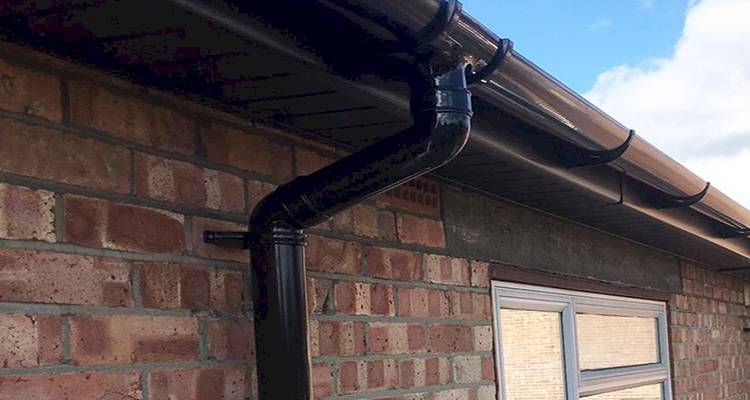
Overall, total costs are influenced by materials, property layout, access requirements, and any additional work like fascia or soffit replacement. Always get tradespeople to assess your home first to determine whether scaffolding or special materials are needed.
Below we take a look at some of these cost impacts in more detail:
- Property size and shape — Smaller homes generally require less material and are straightforward to complete. However, larger properties or complex shapes (such as steep slopes or unusual angles) can lead to higher costs.
- Condition of existing gutters — Damaged or blocked gutters could need a full replacement, rather than just repairs, which can potentially include downpipes and fixings, as well as the gutter itself.
- Material choice — Plastic is cheaper but less durable; metals like aluminium, zinc, or copper cost more but last longer and require less maintenance.
- Aesthetic upgrades — Terraced homes may need specific designs to match the neighbouring gutters, while homeowners may also choose to replace gutters for visual reasons, such as installing copper instead of plastic.
- Damp issues — Water escaping from blocked or damaged gutters can cause issues with brickwork, fascia, or internal walls. Resolving this may require gutter replacement, additional external work, or addressing damp inside the property, which can involve separate damp proofing costs.
- Scaffolding — If required, scaffolding typically takes 2–3 hours to erect, costing on average around £500 for one wall, or twice as much for a complete house. For more detail on access costs, see our scaffolding hire cost guide.
- Fascias and soffits — Replacing the cost of capping fascias and soffits on a 3-bedroom semi typically costs around £800, this is often recommended in order to add structural support to new guttering as well as to prevent further issues.
Common Guttering Issues
Many gutter problems start small, but if they are left too long they can lead to damp, damage to fascias, and the need for a full gutter replacement.
- Blocked or overflowing gutters — Leaves, moss, and debris can cause water to spill over the gutter edge instead of running to the downpipe.
- Sagging or bowing runs — Loose or broken brackets let sections drop, creating low spots where water sits and eventually leaks.
- Leaks at joints and corners — Worn seals or misaligned joints cause drips that can stain walls and fascias over time.
- Cracks, holes, or missing sections — Brittle uPVC or corroded metal can split, letting water escape before it reaches the downpipe.
- Damp patches on walls or fascias — Staining, mould, or peeling paint around the roofline often indicates a long-term guttering issue.
Minor issues can sometimes be fixed with a professional gutter clean or a small gutter repair, while more serious or recurring problems usually point towards replacing the guttering system.
Signs That You May Need to Replace Guttering
Gutters can often be repaired, but there comes a point where a full replacement is more cost-effective and helps prevent damp problems in your home.
- Persistent leaks at joints — If sections keep dripping even after seals or brackets are replaced, the guttering may be warped or worn out.
- Sagging or bowing runs — Pooling water or visibly drooping gutters usually mean brackets have failed or the plastic has distorted over time.
- Frequent overflows in normal rain — If gutters regularly overflow despite being cleaned, they may be undersized for the roof or damaged beyond simple repair.
- Cracks, holes, or brittle plastic — Obvious splits, missing sections, or plastic that snaps easily are strong signs that uPVC has reached the end of its lifespan.
- Damp patches on walls or fascias — Staining, peeling paint, or mould around the roofline often points to long-term gutter leaks that may need a full system upgrade.
If you are seeing several of these signs, it is worth getting quotes for replacement guttering as well as repair so you can compare costs and decide what offers better value in the long term.
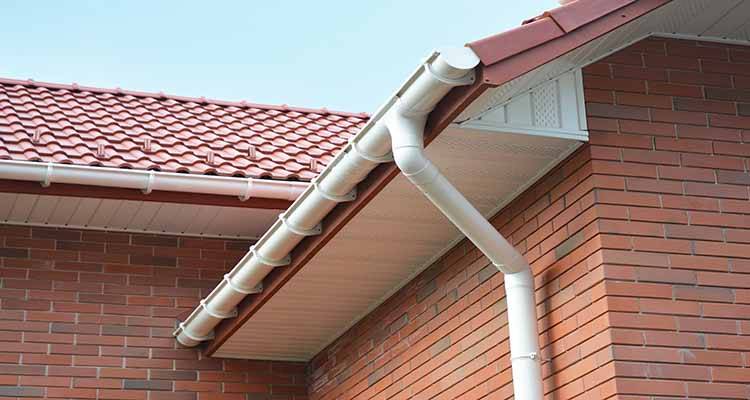
Gutter Repair Costs
For minor issues such as a short leaking section, loose joints, or a damaged bracket, repairing guttering is usually cheaper than a full replacement. On average, small gutter repairs tend to cost around £180 to £250, depending on the material, access, and how much needs fixing.
In many cases, uPVC repairs work out at roughly £20 to £30 per metre, with cast iron and other metals costing more due to higher material and labour costs.
For a full breakdown of typical repair prices, including per metre costs for different materials, brackets, and downpipes, see our dedicated Gutter Repair Cost guide.
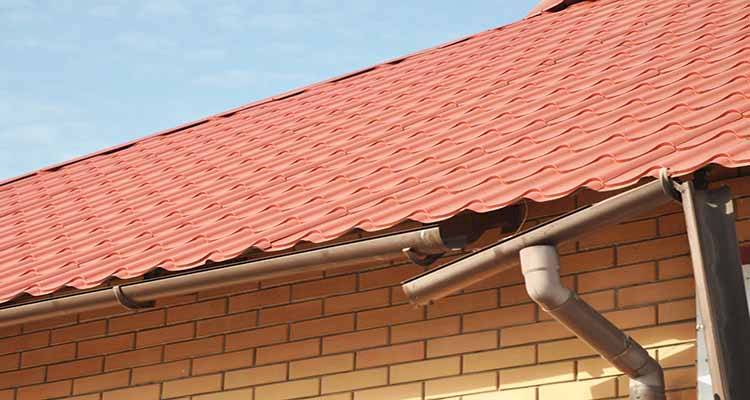
How can I better protect my gutters from windy weather?
There is also wire mesh available to fit between the roof tiles and the gutter to stop leaves from collecting."
Gutter Cleaning Costs
If your gutters are in good condition but clogged with moss and debris, an annual or twice yearly clean will often be enough to keep water flowing properly and delay the need for new guttering.
A professional clean costs from around £75 to £425 depending on the size and height of your property, with most homeowners paying roughly £200 for a standard house.
For a detailed breakdown of cleaning prices and what affects the cost, see our dedicated Gutter Cleaning Cost guide.
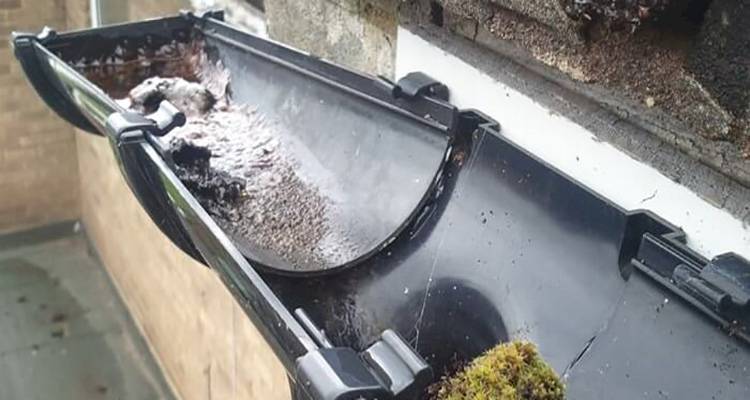
How long can I expect uPVC guttering to last before needing replacement?
Plastic gutters that have been in place for more than twenty years could very well require an upgrade."
Types of Guttering Materials
The material you choose for new guttering affects the upfront cost, how long it lasts, how much maintenance it needs, and how it looks on your home. uPVC is the most common option in the UK, but there are several alternatives that can offer longer lifespans and a more traditional appearance.
uPVC Guttering Cost
- Best for: Budget-friendly guttering on most modern homes.
- Typical cost: Around £2 to £8 per metre (supply only).
uPVC is lightweight, easy to install, and widely available, which keeps both material and labour costs down. However, it has the shortest lifespan of the main guttering materials and is more prone to movement, warping, and UV damage over time.
Pros
- ✔ Low upfront cost compared to metal.
- ✔ Quick and simple for installers to fit.
- ✔ Easy to replace individual sections if damaged.
Cons
- ✖ Shortest lifespan, especially on exposed elevations.
- ✖ Can warp, sag, or crack due to weather and UV.
- ✖ Less robust than metal in high-wind or heavy rain areas.
Cast Iron Guttering Cost
- Best for: Period properties and traditional homes.
- Typical cost: Around £18 to £35 per metre (supply only).
Cast iron is a classic choice for older properties and conservation areas, offering a traditional look and excellent durability when well maintained. It is much heavier than uPVC, so it takes longer to install and usually costs more in both materials and labour.
Pros
- ✔ Traditional appearance that suits period homes.
- ✔ Very robust in strong winds, snow, and heavy rain.
- ✔ Long potential lifespan if correctly painted and maintained.
Cons
- ✖ Significantly more expensive than uPVC.
- ✖ Heavy and harder to handle safely at height.
- ✖ Needs regular maintenance to prevent corrosion.
Aluminium Guttering Cost
- Best for: Longer-lasting, low-maintenance guttering with a modern look.
- Typical cost: Around £22 to £37 per metre (supply only).
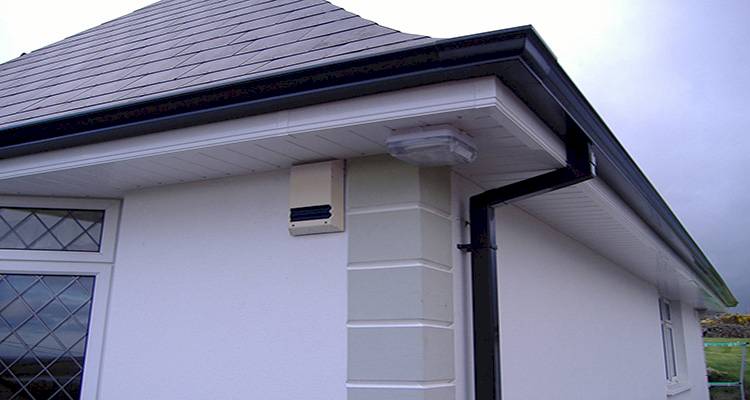
Aluminium offers a good balance between weight, strength, and longevity. It is lighter than cast iron, will not rust, and is available in a range of colours and finishes, but the material cost is higher than uPVC and it can dent if knocked.
Pros
- ✔ Lighter than cast iron but still strong.
- ✔ Resistant to rust and does not crack or fade easily.
- ✔ Available in many colours and coated finishes.
Cons
- ✖ More expensive than uPVC.
- ✖ Can dent if struck by ladders or falling branches.
- ✖ Often seen on commercial buildings rather than cottages or period homes.
Copper Guttering Cost
- Best for: High-end projects and character properties.
- Typical cost: Around £25 to £36 per metre (supply only).
Copper guttering develops a distinctive patina over time and can last for several decades with minimal maintenance. It is one of the most expensive options and needs experienced installers, but it can add real kerb appeal and is fully recyclable.
Pros
- ✔ Very attractive finish that weathers to a patina.
- ✔ Low maintenance and long lifespan.
- ✔ Can be resold or recycled at end of life.
Cons
- ✖ High material cost compared to other options.
- ✖ Installation is more specialist and time-consuming.
Steel Guttering Cost
- Best for: Durable metal guttering at a mid-range price.
- Typical cost: Around £15 to £38 per metre (supply only).
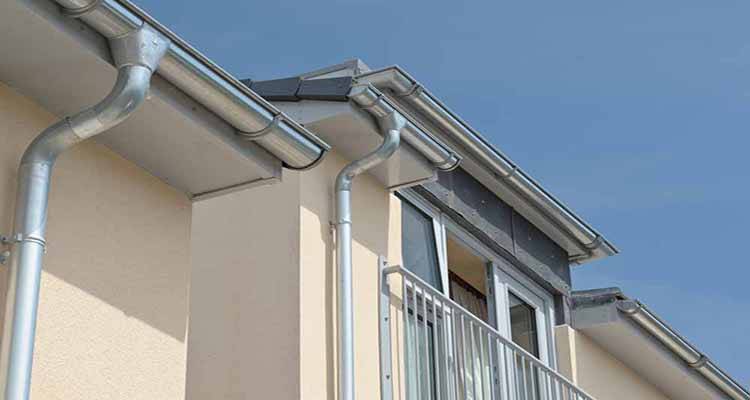
Galvanised or coated steel guttering is strong, impact-resistant, and available in various colours. It usually costs less than cast iron and aluminium but is still more expensive than uPVC and is often chosen for larger or commercial buildings.
Pros
- ✔ Robust and resistant to impact and heavy weather.
- ✔ Can be galvanised and colour-coated.
- ✔ Does not crack or fade easily and can be recycled.
Cons
- ✖ Cheaper than some metals but still pricier than uPVC.
- ✖ Often better suited to commercial or large properties.
Zinc Guttering Cost
- Best for: Long-life metal guttering with a natural finish.
- Typical cost: Around £19 to £30 per metre (supply only).
Zinc guttering forms a natural protective layer that helps it resist corrosion and reduces maintenance. It is lighter than many other metals and has a long lifespan, but it can be vulnerable to acidic runoff or salty air in coastal locations.
Pros
- ✔ Robust with a long lifespan.
- ✔ Retains its appearance better than plastic.
- ✔ Lightweight and fully recyclable.
Cons
- ✖ Can be affected by acidic runoff from some roof coverings.
- ✖ May suffer in coastal areas with regular seawater exposure.
Concrete Gutter Cost
- Best for: Properties that already have concrete gutters and need specialist replacement.
- Typical cost: Around £2,400 on average for full concrete gutter replacement.
Concrete gutters are extremely strong and can last for many decades, but when they fail they often need a full specialist replacement. This type of work usually involves additional brickwork and roof repairs, which is why the overall cost is higher than for standard uPVC or metal systems.
Pros
- ✔ Very durable and structurally strong.
- ✔ Can perform well for many years if maintained.
- ✔ Resistant to heavy rainfall and debris.
Cons
- ✖ High upfront replacement cost compared to other materials.
- ✖ Work may require brickwork and tile repairs.
- ✖ Heavy and less flexible in terms of appearance.
Gutter Profiles and Capacity
As well as material, you will need to choose a gutter profile. Half-round is the most common choice for UK homes, with deeper “deep flow” versions available for higher rainfall. Square and ogee gutters offer higher capacity and a more decorative look, which can suit larger or older properties.
Each profile has a different capacity for carrying water from the roof. As a rough guide for a single downpipe:
- Half-round gutters can handle around 43m² of roof area.
- Square gutters can handle around 70m².
- Deep flow gutters can handle around 90m².
- Ogee gutters can handle around 103m².
Which is better, plastic or metal guttering?
If cast metal gutters are what was originally there, I like to stick with those — they may require more maintenance, but if looked after correctly, they can last a lifetime.
PVC gutters, on the other hand, need less maintenance, are a cheaper alternative, and look great on many different styles of properties."
Cost of Guttering Removal
If you are hiring a professional to replace guttering, removing any old or existing gutter work is likely to be already included within the quote. It is however best to check, as can cost around £150 to £250, depending on property size and access, if you were to pay for this separately.
Using a tradesman will not only bring experience and knowledge of building regulations, but they can also advise if a full replacement is required or if repairing the guttering would be sufficient instead.
Although DIY is possible with a sturdy ladder and basic tools, plastic gutters can be handled by one person, while metal gutters are safer with help. However, by hiring someone to do the job, they can also handle any supplies and arrange scaffolding for hard-to-reach areas where needed. Each section, including downpipes, should be removed carefully to avoid damage.
In the event you need to arrange disposing of waste yourself, then this can usually be taken to your local tip, often free of charge. Other options include hiring a small skip (around £110–£240) or metal gutters can potentially be sold to a scrap metal company or online (typically £50–£100 for a complete cast iron system).
Who can I hire to dispose of old guttering that has been removed? Can it simply go in a skip?
Checklist: Hiring a Gutter Fitter
Hiring a gutter fitter doesn't have to be a complicated process as the work can be carried out by most labourers, but in particular, roofers are most suited to the task at hand.
There are no specific qualifications or skilled equipment required, mostly common sense and an understanding of building regulations as they would need to ensure the right material is used (if matching to an existing system), and that it handles downpour with correct drainage in place.
Below are some points to look out for when hiring someone to help replace guttering on your home:
- What treatments are included? If your gutters need moss or algae treatment, confirm whether this is included in the work.
- Have they assessed your existing system? Ask the contractor to visually inspect your gutters—you might be able to save money with a repair rather than a full replacement.
- Will they handle access requirements? If you have a conservatory or a hard-to-reach roof, ask whether scaffolding is needed, if it’s included in the price, and how much it will cost if it’s not.
- Is waste removal included? Check whether the quote covers the guttering system, disposal of debris, inspection, and any replacement of drainage if required.
- Do they have examples of similar work? Look at customer reviews and testimonials, and see if there are any local properties where you can inspect the company's workmanship firsthand.
- How much experience do they have? The contractor doesn’t need special certifications; focus on their experience and knowledge in installing gutters correctly to prevent damp issues in the future.
- Do they have positive reviews? Check feedback available on MyJobQuote or ask for recommendations from other homeowners who have had similar work carried out.
- Have you obtained multiple quotes? With the help of MyJobQuote make sure you get at least three quotes and have them in writing so you can compare costs and services.



